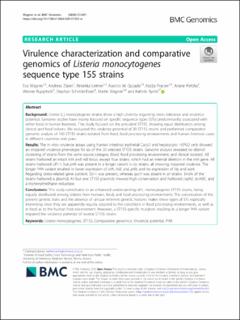| dc.description.abstract | Background Listeria (L.) monocytogenes strains show a high diversity regarding stress tolerance and virulence potential. Genome studies have mainly focused on specific sequence types (STs) predominantly associated with either food or human listeriosis. This study focused on the prevalent ST155, showing equal distribution among clinical and food isolates. We evaluated the virulence potential of 20 ST155 strains and performed comparative genomic analysis of 130 ST155 strains isolated from food, food processing environments and human listeriosis cases in different countries and years. Results The in vitro virulence assays using human intestinal epithelial Caco2 and hepatocytic HEPG2 cells showed an impaired virulence phenotype for six of the 20 selected ST155 strains. Genome analysis revealed no distinct clustering of strains from the same source category (food, food processing environment, and clinical isolates). All strains harbored an intact inlA and inlB locus, except four strains, which had an internal deletion in the inlA gene. All strains harbored LIPI-1, but prfA was present in a longer variant in six strains, all showing impaired virulence. The longer PrfA variant resulted in lower expression of inlA, inlB, and prfA, and no expression of hly and actA. Regarding stress-related gene content, SSI-1 was present, whereas qacH was absent in all strains. 34.6% of the strains harbored a plasmid. All but one ST155 plasmids showed high conservation and harbored cadA2, bcrABC, and a triphenylmethane reductase. Conclusions This study contributes to an enhanced understanding of L. monocytogenes ST155 strains, being equally distributed among isolates from humans, food, and food processing environments. The conservation of the present genetic traits and the absence of unique inherent genetic features makes these types of STs especially interesting since they are apparently equally adapted to the conditions in food processing environments, as well as in food as to the human host environment. However, a ST155-specific mutation resulting in a longer PrfA variant impaired the virulence potential of several ST155 strains. | |
